Civil Rights / Cold War
Nashville Sit-Ins
In the 1950s and 1960s, African Americans began to organize against segregation. It wasn’t enough to ask the federal government and courts for action. Blacks went out and demanded change through demonstrations such as sit-ins and marches.
People who would become active participants and leaders in the Civil Rights Movement ended up in Nashville in the fall of 1959.
- James Lawson came to Nashville to lead workshops on non-violent protests and attend divinity school at Vanderbilt.
- A local preacher, Kelly Miller Smith, was willing to participate in the social gospel he preached.
- Local black colleges and universities, Fisk, Tennessee A & I, and American Baptist, brought in students who were passionate about changing the world.
All these people came together and began the Nashville sit-in movement.
From there they went on to lead other protests across the South. They rode buses as part of the Freedom Rides. They participated in voter drives in Mississippi and Alabama. Some were even beaten and jailed.
From there they went on to lead other protests across the South. They rode buses as part of the Freedom Rides. They participated in voter drives in Mississippi and Alabama. Some were even beaten and jailed.
Picture Credits:
- Photograph of the lunch counter at Walgreens in Nashville on February 20, 1960, where four demonstrators are still sitting even though the management has posted a sign that the lunch counter (called a fountain) was closed. Nashville sit-in demonstrators were taught to continue sitting until they were served, arrested, or told by a leader to leave. Photograph by Jimmy Ellis, The Tennessean
- Photograph of Nashville police discouraging protester. Police use nightsticks to subdue a Nashville demonstrator. Nashville Public Library, Special Collections Division, Nashville Banner Archives
-
Rev. James Lawson speaks to a church meeting on March 8, 1960. Photo by Bill Preston, courtesy of The Tennessean
- Jean Fleming, a Fisk student, sits in the city jail after her arrest at a downtown lunch counter in March 1960. Photo by Jimmy Ellis, courtesy of The Tennessean
- Photograph of a young African American carrying a sign that says "Dignity before Dollars." The photograph was taken in Nashville at the entrance to the Arcade on Fifth Avenue. Walgreens, a target of lunch counter protesters, is in the background. This was part of the highly effective Easter boycott in Nashville where African Americans refused to shop in downtown Nashville stores because of segregation rules. Special Collections, Nashville Public Library, Nashville Banner Collection
- During the sit-in protests, four Nashville participants have lunch at the once segregated lunch counter at the Post House Restaurant in the Greyhound bus terminal on March 17, 1960. Although protesters had earlier been arrested for attempting to eat at the counter, that day, the management decided to serve them. From left to right are Matthew Walker, Peggy Alexander, Diane Nash, and Stanley Hemphill. Photo by Gerald Holly, courtesy of The Tennessean
- James Lawson speaks to a crowd of nearly 1,000 people at Gordon Memorial Methodist Church in a meeting about the lunch counter sit-ins on May 8, 1960. Photograph by Bill Preston, Courtesy of The Tennessean
Civil Rights / Cold War >> Civil Rights Movement >> Nashville Sit-Ins >>
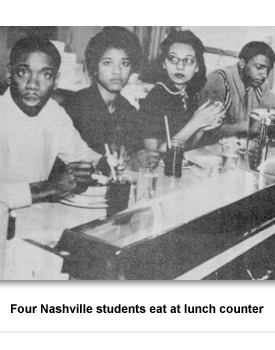
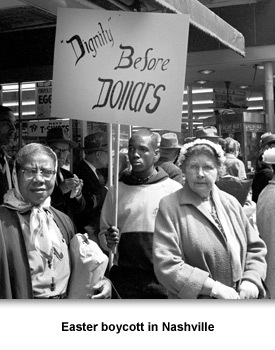
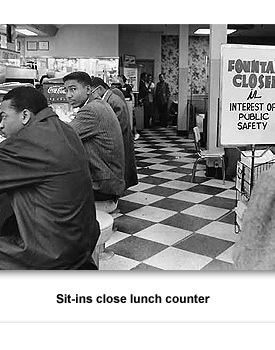
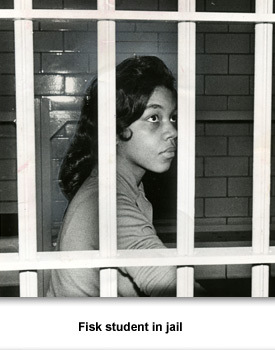
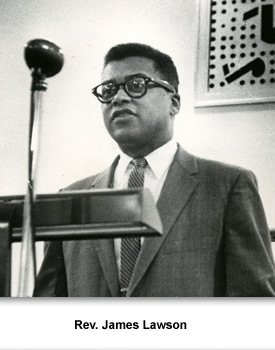
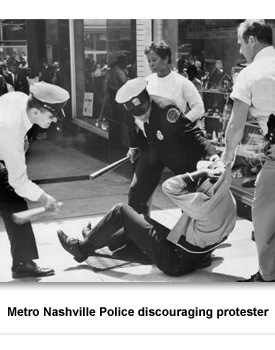
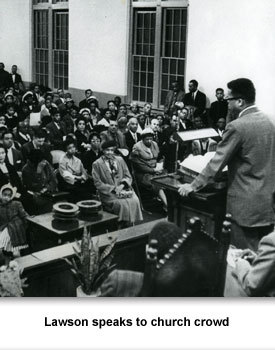
 Sponsored by: National Endowment for the Humanities
Sponsored by: National Endowment for the Humanities